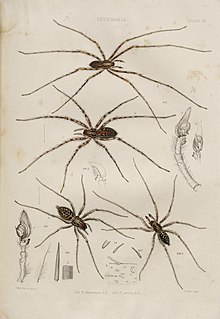
The hobo spider is a member of the genus of spiders known colloquially as funnel web spiders, but not to be confused with the Australian funnel-web spider. Individuals construct a funnel-shaped structure of silk sheeting and lie in wait at the small end of the funnel for prey insects to blunder onto their webs. Hobo spiders sometimes build their webs in or around human habitations. The hobo spider lays its eggs in September and they hatch during late spring. After the male hobo spider mates it dies.

The Pholcidae are a family of araneomorph spiders. The family contains over 1,800 pholcids, including those commonly known as the marbled cellar spider , daddy long-legs spider, granddaddy long-legs spider, carpenter spider, daddy long-legger, vibrating spider, gyrating spider, long daddy, and skull spider. The family, first described by Carl Ludwig Koch in 1850, is divided into 94 genera.

The Agelenidae are a large family of spiders in the suborder Araneomorphae. Well-known examples include the common "grass spiders" of the genus Agelenopsis. Nearly all Agelenidae are harmless to humans, but the bite of the hobo spider may be medically significant, and some evidence suggests it might cause necrotic lesions. However, the matter remains subject to debate. The most widely accepted common name for members of the family is funnel weaver.

The spider species Araneus diadematus is commonly called the European garden spider, diadem spider, orangie, cross spider and crowned orb weaver. It is sometimes called the pumpkin spider, although this name is also used for a different species, Araneus marmoreus. It is an orb-weaver spider found in Europe and North America.

Tegenaria is a genus of fast-running funnel weavers that occupy much of the Northern Hemisphere except for Japan and Indonesia. It was first described by Pierre André Latreille in 1804, though many of its species have been moved elsewhere. The majority of these were moved to Eratigena, including the giant house spider and the hobo spider.

The spider species Tegenaria domestica, commonly known as the barn funnel weaver in North America and the domestic house spider in Europe, is a member of the funnel-web family Agelenidae and a close relative of the hobo spider.

The giant house spider has been treated as either one species, under the name Eratigena atrica, or as three species, E. atrica, E. duellica and E. saeva. As of April 2020, the three species view was accepted by the World Spider Catalog. They are among the largest spiders of Central and Northern Europe. They were previously placed in the genus Tegenaria. In 2013, they were moved to the new genus Eratigena as the single species Eratigena atrica. In 2018, the three separate species were restored. The bite of these species does not pose a threat to humans or pets, and they are generally reluctant to bite, preferring instead to hide or escape.
The name house spider is a generic term for different spiders commonly found around human dwellings, and may refer to:

Tegenaria ferruginea or charcoal spider is a European reddish, rather common spider with rusty markings on its back. The body looks rather similar to T. parietina, however the legs are much shorter and the funnel web built lacks backdoor exit. It was transferred to Malthonica in 2005, but back to Tegenaria in 2013.

Tegenaria parietina is a rather rare spider in Europe, with a distribution also including Northern Africa to Central Asia and Sri Lanka, and from the West Indies to Uruguay and Argentina, where it may be introduced. In the UK it is sometimes known as the cardinal spider because of the legend that Cardinal Wolsey was terrified by this species at Hampton Court, or, conversely, because he regarded them as lucky and forbade anyone to harm them. In 2013, Tegenaria taprobanica was included in this species.
Malthonica is a genus of funnel weavers first described by Eugène Simon in 1898. Many of its species were transferred to Aterigena and Tegenaria in 2010.
Tegenaria bozhkovi is a funnel-web spider found in Bulgaria and Greece.
Tegenaria bosnica is a species of funnel-web spiders found in Bosnia-Herzegovina, Croatia, Montenegro and Serbia.
Tegenaria croatica is a funnel-web spider found in Croatia.
Tegenaria decolorata is a funnel-web spider found in Croatia.
Tegenaria abchasica is a spider species found in Russia and Georgia.

Eratigena is a genus of spider in the family Agelenidae. Most of its species were moved from the genus Tegenaria in 2013. Two species that frequently build webs in and around human dwellings are now placed in this genus. Eratigena agrestis is the hobo spider, native to Europe and Central Asia, introduced to North America. Eratigena atrica is the giant house spider, native to Europe and also introduced into North America.
Aterigena is a genus of funnel weavers first described by A. Bolzern, A. Hänggi & D. Burckhardt in 2010. The name is an anagram of Tegenaria. It was created in 2010 for a group of Tegenaria and Malthonica species that formed a clade in a phylogenetic analysis. The genus was later found to be monophyletic, further separating Eratigena from Tegenaria and Malthonica.

Eratigena duellica, the giant house spider, is a species of funnel weaver in the spider family Agelenidae. It is found in Canada, the United States, and Europe. The related species Eratigena atrica is also called the Giant house spider.











